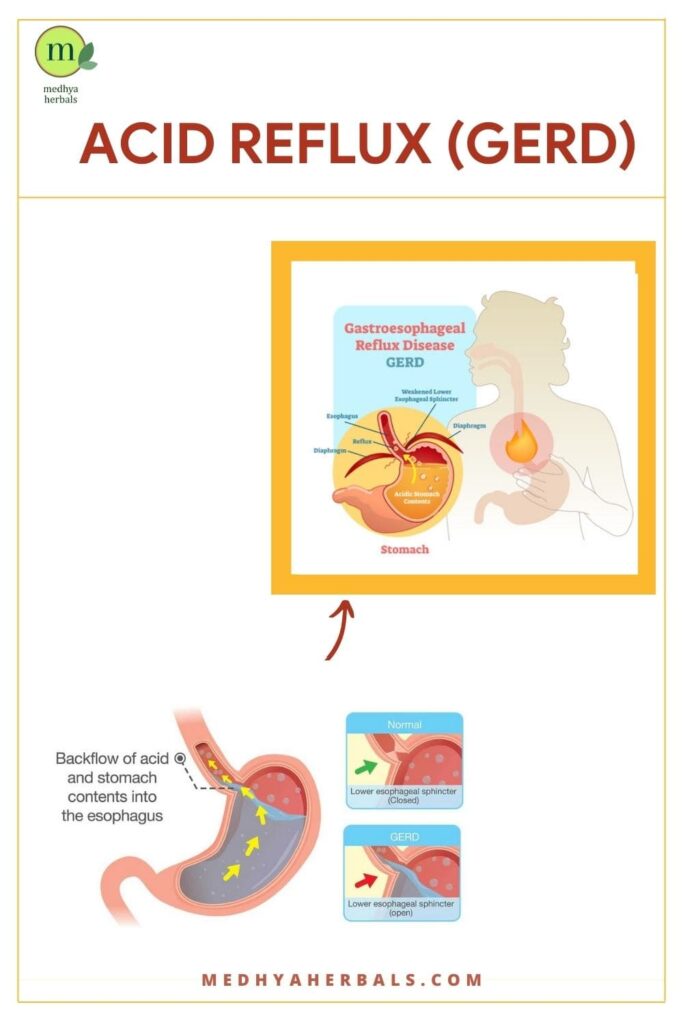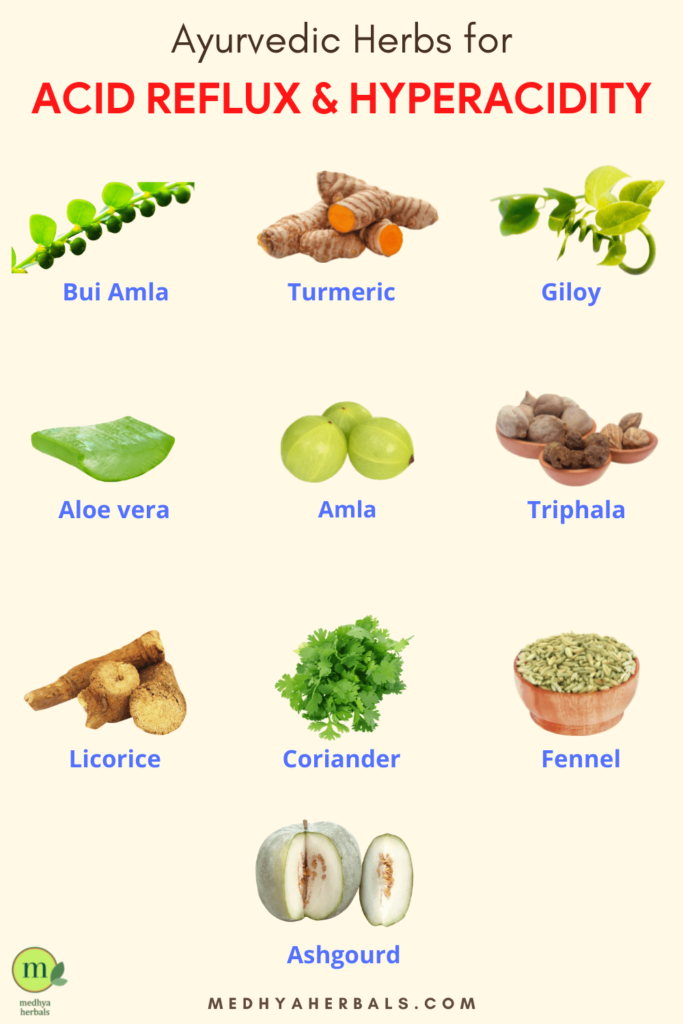Hyperacidity, heartburn and a constant feeling of heaviness in the abdomen are common signs of poor digestion that arises in pitta dosha imbalance. Usually the symptoms of hyperacidity start as a burning sensation in the abdomen.
You may be prompted to ignore it or pop in an antacid to find relief. Unfortunately, this approach pushes the digestive problem towards the extreme end. As a result, the slight discomfort turns into a chronic problem of GERD or constant abuse of antacids severely disturbs the digestive system functioning.
That’s why, a purely lifestyle disorder that arises in poor choices of diet and lifestyle, hyperacidity should be treated in a natural way through healthier foods and food habits. This is the best and surest way to find relief from heartburn and acidity!
And Ayurveda can help you to achieve that.
Ayurvedic treatment for hyperacidity targets individual specific symptoms and prescribes suitable herbs, foods and lifestyle to remove the root cause and heal the digestive tract. Let’s see how!
What is Hyperacidity (Acid Reflux) and Heartburn?
Acid Reflux, also known as hyperacidity is a condition in which the stomach contents back up into the esophagus. Hyperacidity usually accompanies severe discomfort, pain and burning sensation in the upper digestive tract leading up to the throat. It is often termed as heartburn!
Heartburn is a common symptom of GERD and Acid Reflux, but to varying degrees of intensity. It’s like a gradation from one level of ‘burning’ to the next.
The stomach stores highly concentrated acid (HCl) that helps in digestion. That’s why any back flow of this acidic content causes the upper digestive tract to get burnt and bruised.
The pain is felt more severely in the esophagus because the protective lining there is more delicate than that in the stomach.
Why does Acid Reflux Happen?
What causes the stomach acid to back up in the first place? Well, between your stomach and your esophagus (pipeline of upper digestive tract) is a sphincter, which is a ring of muscle. This sphincter is the gatekeeper and mediates the passage of materials between the stomach and the esophagus.
This sphincter is called the Lower Esophageal Sphincter (LES). It opens up when you eat or drink. This allows the swallowed substance to pass into the stomach to begin or continue the process of digestion.
However, sometimes the LES is not able to close properly. As a result, it fails to carry out its gate-keeping work efficiently. As such, it allows the back flow of stomach contents back into the esophagus.
What is Gastro Esophageal Reflux Disease (GERD)?
GERD is hyperacidity at an advanced and chronic level. The transition to GERD occurs when acid reflux occurs two or more times in a week.
Usually, at this point the situation starts to get worrisome, as it can lead to severe health symptoms and health risks as:
- Damage to tooth enamel due to exposure to excess acid
- Heartburn
- Regurgitation
- Chest pain
- Persistent dry cough
- Trouble swallowing
- Asthma
- Bad breath
Aside these symptoms if GERD is left untended, it can cause the rising of secondary issues such as inflammation of the esophagus- esophagitis and even cancer!
What causes Acid Reflux and Heartburn?
Acid reflux is triggered and aggravated by excessive production of acid in the stomach or low acid production too. In addition poor function of LES due to weakening of the muscles cause the back flow from stomach to upper digestive tract.
All of this can happen as a result of poor diet, lifestyle, excessive stress and life stages that make you prone to hormonal imbalances.
- Over consumption of food containing hard to digest foods as animal products including meat and dairy
- Consumption of excessive salt, spices, chili, fried and processed foods
- Untimely and rushed meals
- Obesity and high belly fat
- Hiatal hernia that reduces pressure in LES, thus leaving it loose
- Smoking and Alcohol abuse
- In pregnancy, heightened levels of progesterone relaxes the Lower Esophageal Sphincter (LES) leading to acid reflux. Aside this, the increased abdominal pressure due to the growing uterus increases reflux. The symptoms of GERD usually worsen in the third trimester of pregnancy
- Medications like antihistamines, calcium channel blockers, sedatives/pain relive drugs and antidepressants all serve to weaken the LES

What are the Symptoms of Hyperacidity?
There are various signs that your body gives to indicate an acid indigestion like the symptoms given below. If you notice one or more of the following symptoms on a daily basis over a prolonged period of time, it may very well be due to hyperacidity.
- Cold and Sore Throat
- Sour taste in mouth
- Sour or bitter belching
- Bitter taste in the back of the throat
- Burning and pressure that can extend to around the breastbone
- Heartburn, Throat burn, Mouth ulcers
- Heart & chest burn (behind the breastbone)
- Nausea, Vomiting & Aversion towards food
- Indigestion & Heaviness in abdomen
- Regurgitation of food or sour substance
- Gaseous distention & pain in abdomen
- Chest pain and or headache
- Bad breath and excessive thirst
- Foul smelling loose motions
- Burping and belching
- Severe burning sensation over feet, hands
- Fatigue (especially in legs), Tiredness, Fainting, Giddiness
- Itching all over the body
Ayurvedic Perspective of Heartburn, Acid Reflux and GERD
Hyperacidity is known as Amlapitta in Ayurveda (Amla means sour and Pitta means heat). It arises due to an increase in pitta dosha, which leads to excess heat and sourness in the body.
The aggravated Pitta dosha impairs the digestive fire, leading to improper digestion of food and production of ama (toxins). This ama gets accumulated in the digestive channels, thus blocking the normal functioning of the digestive system.
A sub dosha of Pitta, the pachaka pitta influences the stomach acid, digestive enzymes and pepsin, which all aid in digestion in one way or another. This increases stomach acid production, leading to a perpetual feeling of hunger, weight loss, sour and bitter taste and burning sensations.
Acid reflux can also happen due to Kapha dosha imbalance and manda agni. This leads to indigestion, heaviness and reduced production of stomach acid (less sourness). As a result stomach contents are not emptied fully into the lower intestines.
This can build up back flow with food materials leading to high mucus, cough, a sweet taste in mouth after meals, chest congestion in the morning, a heavily coated tongue and a tendency to pile on weight.
Ayurvedic Treatment for Hyperacidity
Hyperacidity treatment in Ayurveda focuses on balancing the dosha and digestive fire, removal of toxins and supporting normal functioning of the digestive system. This helps to cure hyperacidity at its root cause level and also avoids any recurrences.
Ayurvedic treatment involves generous use of cooling herbs, digestive tonics along with specifically planned diet and lifestyle changes. As the saying goes “Prevention is better than cure” it is better to avoid all the causative factors of Amla-pitta.
1. Ayurvedic Herbs for Hyperacidity and GERD

Ayurveda recommends cooling herbs to regulate the formation of acids and thereby to reduce the burning sensation in the digestive tract. Here are some helpful Ayurvedic formulations and herbs:
All the herbs and formulations that have been shared in this post are for information purpose only. All of these are potent Ayurvedic medicines that should be taken under the supervision of a qualified Ayurvedic doctor only. Do not indiscriminately use Ayurvedic herbs as it may cause more harm than benefit.
1. Bhumi amalaki
It is an excellent Ayurvedic medicine to detox, support liver health and pacify Pitta Kapha dosha.
2. Amla
Amla keeps the Agni fire in check. So, it regulates metabolism and prevents the formation of excess stomach acid.
3. Giloy | Guduchi
Giloy fights inflammation. Alongside that, it has various health benefits:
- Detoxification
- Improves the function of the digestive tract
- It helps regulate blood sugar levels if consumed routinely.
- It plays a role in regulating blood pressure.
4. Triphala
This herb aids digestion. It is a combination of three herbs: Amla, Behada, and Harad. You stand to gain a lot from Triphala. Here are some health benefits:
- Boosts metabolism
- Improves bowel movement
- Detoxification of body cells
- Boosts immune system
5. Turmeric
Turmeric is a well-known blood purifier and anti-inflammatory herb It comes packed with an abundance of health benefits:
- Reduces inflammation and prevents infection.
- Strengthens the immune system against various pathogens.
- Turmeric improves the function of the digestive tract and removes toxins from the blood.
6. Aloe Vera Gel
It helps to pacify both Pitta and Kapha dosha and reduce heat in the body. Aloe also supports healthy gut lining and regular bowel movement.
7. Fennel
It is a cooling herb that stimulates the digestive fire and supports proper assimilation of food. Chew 1 tsp fennel seeds after every meal to keep your digestive system functional and healthy.
8. Coriander
Both the seeds and leaves are great to balance Pitta dosha, heat and acidity in the body. Regular use of coriander also flushes heavy metals out of the body, thus promoting detoxification and liver support.
9. Mulethi (Licorice)
Liquorice neutralizes the acids quickly to give relief. It also heals the gut lining and supports healthy function of the digestive system. Additionally, licorice helps to balance the hormones.
10. Ashgourd
Peel off the ashgourd and make a pulpy juice out of it. Half a cup twice daily gives fast recovery from gastritis and acidity.
2. Vihara: Ayurvedic Lifestyle to Prevent Acid Reflux
A few simple lifestyle adjustments can go a long way to alleviating the symptoms of and preventing heartburn altogether:
- Weight loss can significantly reduce the risk of developing GERD.
- Quit smoking and drinking.
- Do not lie down immediately after eating. Give it some time, perform light activities for a while.
- Avoid mental stress and worries. Yoga, meditation, and other mindfulness exercises can help with that.
- Chew fennel seeds after your meals to support digestion and pacify Pitta Kapha dosha.
- As per Ayurveda, people who sleep on their left side can increase digestive fire and risk hyperacidity. Sleeping on the right, however can aggravate vata. Alternating sides is a good practice.
3. Ahara: Ayurvedic Diet to Treat Acid Reflux
Your diet and foods that you consume should help you to balance your digestive fire and support healthy elimination.
Here is a list of foods that will help you to reduce and prevent hyperacidity and heartburn. These foods and dietary habits also promote balance of kapha and pitta dosha.
These food items are best eaten when properly cooked, steamed or stir-fried.
Whole Grains
- brown or unpolished rice
- whole wheat
- spelt
- oats
- barley
Sweet Vegetables
Take in well-cooked or steamed veggies such as:
- beets
- carrots
- okra
- zucchini
- yellow squash
- winter squash
- sweet potatoes
- asparagus
- sweet peas
Sweet Fruits
Favor sweet, juicy fruits such as:
- ripe mango
- peaches
- soaked raisins
- dates
- avocados
- coconut
- fresh figs
- pear
- ripe apricots
- watermelon
- sweet plums
4. Worst Foods that You Should Avoid for Heartburn
According to Ayurveda sour, salty, and bitter tastes can aggravate Pitta and Vata dosha. Hence, foods that are naturally tasting any of these should be consumed in moderation.
Additionally, you should avoid processed foods and all the stimulants that create toxins in the body. Here’s a list of foods and dietary habits that you should avoid:
- Alcohol & Smoking – Stay away from Smoking and Alcohol consumption as it dehydrates and leads to Pitta Dosha Imbalance. If you have high level imbalances, then alcohol consumption, even in limited quantity can make hyperacidity symptoms worse. Hence, you should avoid it altogether.
- Caffeine – Remove all caffeinated drinks and beverages. Caffeine leads to dehydration and Pitta aggravation. Avoid caffeinated drinks, mocktails, coffee, and black tea.
- Spicy and Hot foods – Pungent herbs, cayenne pepper, chili are some of the most heating herbs that directly aggravate Pitta. Spicy foods can immediately trigger a series of hyperacidity symptoms.
- White Flour Items – White flour items act on long term accumulation of toxins in the body and act as causes of hyperacidity and poor digestion.
- Animal Products as seafood, red meat, excess meat, poultry and dairy.
- Refined oil, margarine, fried foods
- Avoid raw, stale and burnt foods
- Nightshades such as tomatoes, white potatoes, peppers, and eggplant
- Avoid skipping meals or staying hungry for too long
- Fermented and excessively sour foods
- Raw and cold foods
5. Practice Pranayama (Breathing Exercises) | Natural Remedies for Hyperacidity
Regularly practice stress-reducing activities as yoga, pranayama and meditation. This will help to increase your body’s capacity to handle stressful situations.
Stress management helps to prevent the onset of hot flashes. Low stress also reduces the frequency of hyperacidity symptoms.
Pranayama is one of the best ways to balance dosha. It naturally calms down the mind, supplies ample of oxygen throughout the body and supports metabolism.
Here are some of the breathing exercises that you should regularly perform for natural treatment of heartburn and acid reflux.
1. Slow exhalations
Yes, this is the one you’re much familiar with. Almost everyone does this, And truly, it is one of the best of them. Inhale and exhale slowly.
Physiologically, your heart rate picks up when you breathe in and slows down when you breathe out. Therefore, inhale, and then exhale slowly.
In that way, you can bring your heart rate down.
2. Bramhari (Bumble bee breath)
This asana is called the bumblebee breath because of the sound you have to make while performing it. It is like that of a bumblebee.
As before, you inhale and exhale slowly, but this time you keep your lips sealed and make an ‘M’ sound while exhaling.
Exhale for as long as you can. However, don’t stretch to the limits of your endurance. Else, it will have the opposite effect. Your heart rate will pick up and you will feel more stressed instead.
3. Ujjayi breath (ocean breath)
This is quite common also. You make a sound like the ocean.
It is also performed with the mouth closed and the throat constricted. This brings about a restriction in airflow, causing the ‘ocean sound’ to be made as you are breathing.
4. Sahita khumbaka Breath
Khumbaka means ‘retention of breath.’ This is not to be confused with ‘holding of breath.’
The essence of this breathing technique is to be aware of your breathing cycle, not to control it. You are to pay attention to the point where your breathing switches from inhalation to exhalation. Take note of it with each breath. You will find this a very relaxing exercise.
5. Nadi shodhana (Alternate nostril breathing)
The technique is quite obvious from the name. It’s like you breathe through one nostril and then through the other.
Here is how it goes.
- First, inhale with both nostrils and exhale as you normally would.
- Next, block your right nostril with your thumb and index finger(preferably of your right hand), and inhale through the left.
- Release the right, block the left nostril, and then exhale through the right nostril.
- Next, inhale through the right nostril.
- Then release the left, block the right, and inhale through the left nostril.
This is one round, and you can perform five rounds.
6. Reduce Stress to avoid the triggers of Hyperacidity
Stress reduction should be done by avoiding all triggers of stress such as last minute deadlines, lack of planning, and taking up too many tasks.
- Better manage your day and health by planning, prioritizing, and defining your limits.
- Avoid all heaty, stressful, and extremely pressing/competitive situations.
- Give yourself the opportunity to savor both the meal and the ritual that surrounds you. This will help in reducing stress in your daily life. It will also regulate the inner rhythms of your hormones, blood pressure and even body temperature.
- Practice regular sleep times and avoid staying up till late. Lack of sleep disturbs all three doshas and triggers acid reflux with higher intensity.

7. Exercise to help with Heartburn
Physical activity is highly effective when it comes to management of hyperacidity and healthy digestion.
Regular exercise leads to better physical strength and improved circulation. It also helps to improve metabolism and detoxification.
- Relaxing physical activities that include nature walks, swimming, slow walking, bicycling are highly helpful to manage heartburn symptoms.
- Perform yoga that can improve circulation and regulate Pitta and Kapha Dosha in your body.
- Brisk walk, specifically in nature is one of the best remedies to stress. It also helps to prevent insomnia, which are often intimately related with hyperacidity and heartburn.
- Extreme activity increases the core body temperature. It thus results in GERD in patients, who are sensitive to temperature changes.
Now we want to hear from you. Do write to us for any queries and feedback. If you have tried any of the above Ayurvedic natural remedies for heartburn, then do share your experience with us. We will get back to you the soonest.
Wishing you vibrant health!
References
Effectiveness of Ayurveda treatment in Urdhwaga Amlapitta: A clinical evaluation

